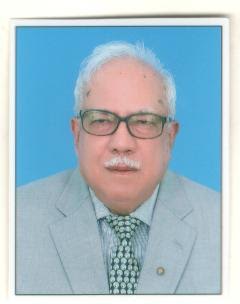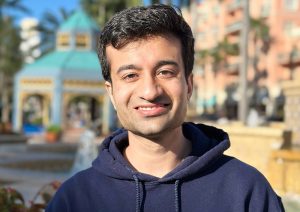Engineer Sibte Ahmed Jafri,
FIEEE (Pak.), FIE (Pak), PE
CEO Jafri and Associates Private Limited
Let us look at the Scenario that world is facing today:
Doubling of world population during next 50 years and possibly tripling of Electrical Power demand. Problem of power plant siting, environmental impact. Resource shortage increasing shortage of space for power generation and transmission distribution. If current impacts are extrapolated they will lead to irrevocable harm to environment and will still not meet the future power needs. The increased lengths of Transmission and Distribution system would continue to add to the system losses which currently stand 8% plus even in developed countries. (These are just the technical losses not allowing for “unaccounted losses”). Old saying goes somewhat like this: One joule saved is far better than one joule generated. In fact it takes significantly more than 1 joule to generate 1 joule of power. Environmental impact and energy losses associated with the construction of a power plant in today’s world have serious consequences. Very seriously speaking one may need to look to upper space for future energy needs. (Indeed serious futuristic experiments are going on in this direction). Solar Energy is an inexhaustible nonpolluting source which does not alter the global thermal balance.
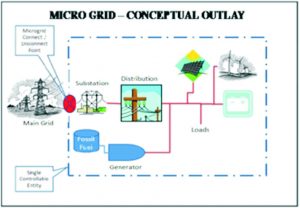
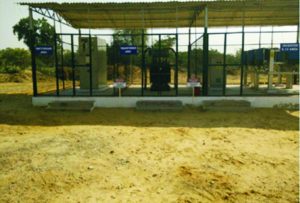
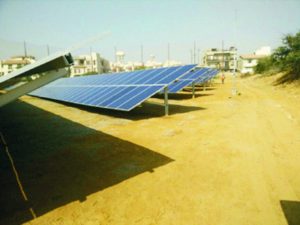
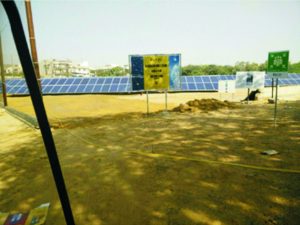
Centralized Versus Distributed Power Generation
Technologies for Distributed Generation as described by A Reciprocating Engines – Uses compressed Air and fuel.
As basic load with Co-generation facility upto 45% efficiency can be obtained. Lower as peaking or standby unit’s efficiencies of 25 to 30 % are obtained.
Gas turbines mostly in Co-generation few as standby or peaking. Micro turbines same as Gas turbines but lower capacity and high speed. Decentralized Generation, Dispersed generation, Distributed Energy Resources are various terms used for the “Distributed Generation”; the topic for my paper. Maximum limit on the size can range from 1 MW to 100 MW depending upon technology, capacity, method of connection etc. Since 1990 electricity production has been moving towards generation concentration and a higher degree of integration leading to the current centralized concept.
Economics of Scale especially on account of development of large sized steam turbines.
Innovation in the transmission system
Location away from population centers reducing the environmental impact.
Increased lengths of Transmission and distribution lines has led to increased losses especially when spares load, such as rural electrification is concerned and increased unaccounted losses.
T&D costs 3000 to 3,500 billion are expected to be invested upto the year 2030. Security and reliability points to distributed generation which can also be used as back up. Recent experience when long scale long period shut downs have taken place even in the developed World.
Increased efficiency through renewable energy and co-generation
Main Characteristics of distributed generation standby generator, peaking generator, Quick recovery time.
Energy efficiency and environmental benefit e.g. CHP and Waste Heat Recovery
(compared to 35 – 37% average efficiency of fossil fuel generation CHP systems can reach an efficiency of upto 90% capturing the Waste Heat and using it for heat demand in houses business centers and towns).
For the Rise of Distributed Power mostly the following countries are taken as example: •China •Mexico •Egypt •Myanmar •India Smaller cost and less time to add generation capacity
Co-Generation relies heavily on Distributed Generation as heat transmission and storage is the source of significant energy losses.
Some Specific advantages of Distributed Generation:
Can be installed quickly
Economical in installing and operating
Supply can be sized to match the demand and can be increased when required.
Can be located close to loads allowing better control On the other hand Distributed Power is used extensively in Europe; Denmark being the leader. Distributed Power was the beginning of the Power Generation and utilization.
1900- 100% distributed Power
1950 less than 10%
2010- Distributed power 36%
Fuel Cell It is said that in 2012, $ 150 billion was invested in 142 GW of distributed Power capacity. During same year 218 GW of Central Power capacity was ordered that would mean that distributed power addition accounted for 39% of total Global capacity during that period. Projected investment increase from 142 to 200 GW from 2012 to 2020 i.e. 58 GW at 4.4 % growth rate; estimated investment in Distributed Power from $ 150 billion in 2012 to $ 206 billion in 2020.
Consideration for Integrated System Connection charges
Connection costs and part of reinforcement cost of the system, proportional to its use in the Distributed Generation component. This aspect needs to be considered if the Distributed Generation accounts for a large share of total Generation. If the incremental cost to accommodate Distributed Generation is not considered, the Network Operator is not seriously interested in opting for Distributed Generation.
Energy losses
Compensation by buying energy from the Distributed Generation. Innovation is needed to integrate the Distributed Generation in the network e.g. smart grid or micro grid. It is not necessary that the Distributed Generation is more environmental friendly unless of course one is considering renewable sources e.g. fuel cells, PV Solar or small wind turbines. On the other hand Diesel Engine Generators (having currently maximum population in the family) are perhaps one of the worst emitters of carbon. Co-generation is more relevant in Europe where heat is needed for central heating. In warm climates such as Pakistan, heat is used for operating AC system but economics does not always point to such a system. Electric security – supply security. Most of the Distributed Generation run on natural gas. Supply of gas has a question mark.
An example Solar power utilization to reduce cost of electricity and pollution
A Club for Example obtains its income through entrance fees and monthly subscription. The entrance fees is deposited in bank as fixed deposit and the “Profit” through the deposit helps the club in its running expenses and towards costs of construction and maintenance of facilitates. Until few years back the rate of profit was up to 13% however recently it is down to 5% to 6%. The club decides to invest part of its investment in putting up a PV Solar Plant. The 350 KW plant costs say Rs. 35 million. The monthly saving in cost of electricity is Rs. 800,000 (i.e. around Rs. 10 million a year). The land is clubs own and for Power Distribution existing facility is used. The entire investment is returned in about 4 years (the main cost of a PV Plant is its capital cost the O&M is nominal). o after four years the club saves Rs. 1 million a year and the country benefits through saving in (proportional) in fossil fuel cost and pollution. Let us look at Rural Electrification in Morocco for example where use of PV System increased from 18% in 1995 to 98% in 2011. (The proportion varies from country to country). PV System is usually integrated with Diesels if operating in standalone mode. In most countries 15 KM distance from Grid is considered economical for rural electrification. (The village electrification project we did in Sind Region. The max allowable distance was 30 KM from Grid). To support PV installation Battery storage is considered too expensive compared to Diesel Gen Set. But then with DG set one has to be ready for pollution.


